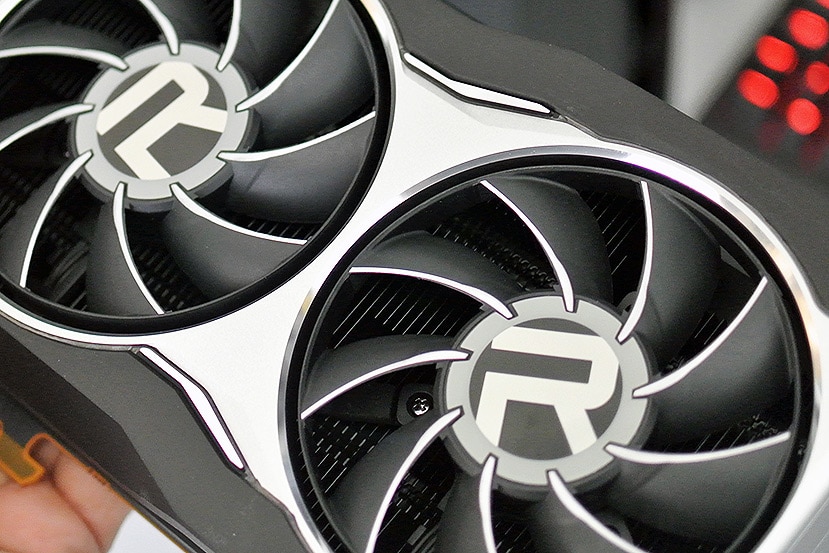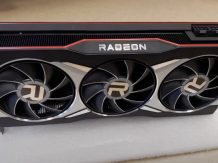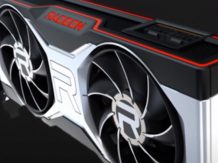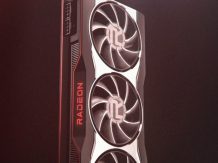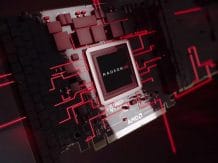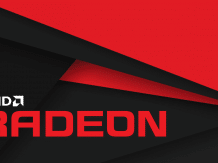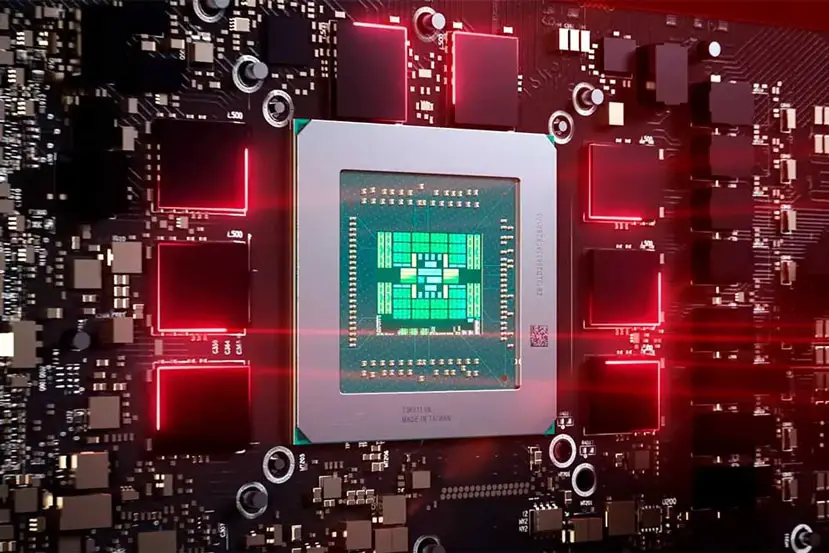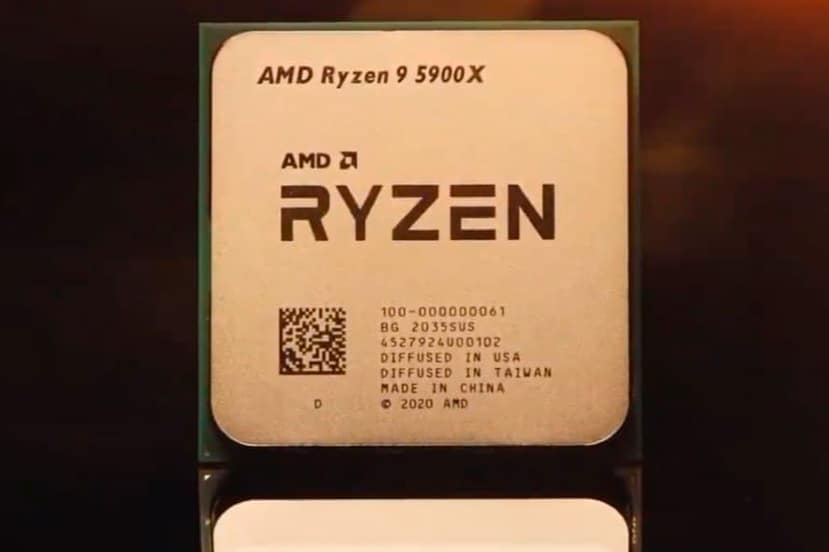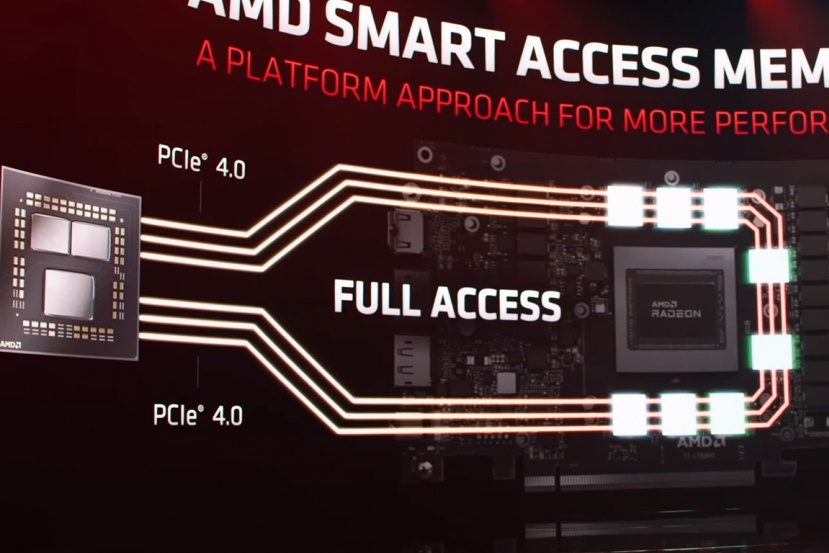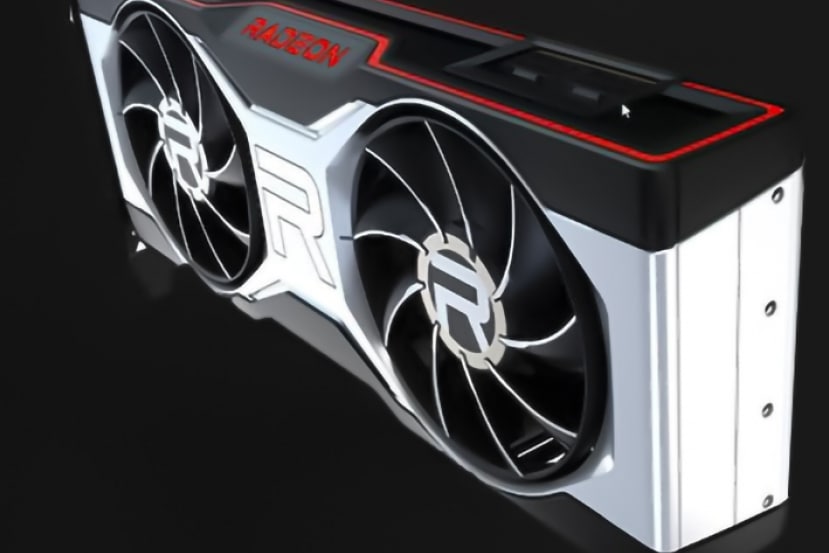AMD Radeon RX 6800 Review: Checkout the Specs, Hashrate, CPU performance, profitability, payback period and the best coins to mine with this Radeon. AMD’s second generation RDNA graphics have been made to beg, but also the latest generation of Nvidia’s GeForce RTX graphics, but now we are presented with a very interesting end of the year 2020 with renewed graphics options by the two main competitors of the market, also at a key moment for AMD since two new next-generation consoles are also presented, also based on their GPUs.

Introduction to AMD Radeon RX 6800 Features
As for the RDNA2 architecture, which brings the Radeon RX 6800 and Radeon RX 6800 XT to life, from AMD comes hand in hand with familiar things, such as its ability to take advantage of the latest PCI Express 4.0 connectivity, now enhanced with renewed options. graphics to Smart Memory Access available with their latest chipsets and processors.
They also come from the hand of new designs and new Turbo methodologies that add to its experience with the 7nm FinFET processes developed by TSMC . Just a few days ago we saw how the Zen3 architecture does wonders with this process, which for AMD is already in a mature phase, and now we find it again with a new architecture that introduces three fundamental pillars of improvement with which AMD wants to put the foundations of his reconquest of the graphics market for PC.
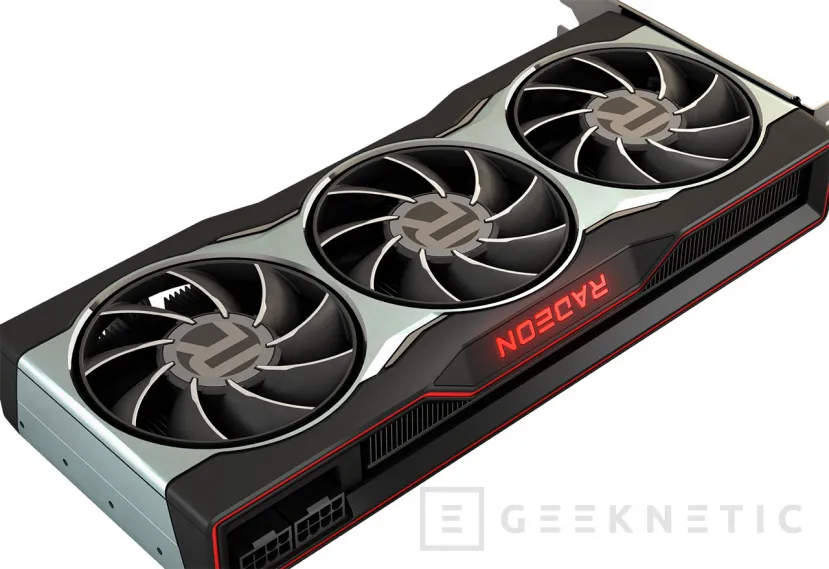
New Features in AMD RDNA 2 Generation
As we will see later during our tests, the new AMD graphics have a significant improvement in performance per watt compared to the previous generation, which allows it to do much more damage to the latest Nvidia products than in previous generations.
These three pillars on which AMD’s RDNA 2 architecture is based are the increase in compute units, the increase in work frequency and the introduction of the Infinity Cache. Although my colleague Antonio explains it in much more detail in this technical analysis of architecture, I will also give you some hints of what these three improvements mean.

The increase in the RDNA 2 computing units allows not only to increase the card’s processing capacity in classic shading techniques, but also introduces specific units for RayTracing, but always within the DXRT standard that Microsoft introduced some time ago. time in the DirectX 12 API and already used by many games on the market. The increase in computer units (CU) is 30% in the most basic model of this new generation and double in the most powerful model of this new range.
The second important pillar of performance improvement is found in the ability of these cards to develop higher work frequencies at stake with consumption similar to those of the previous generation, specifically between 250 and 300 watts TDP. We can find up to 400MHz more turbo frequency in some of the models compared to the previous generation and this is achieved, to a large extent, at the temperatures that this new architecture is capable of supporting.

This generation of AMD graphics chips can withstand “T-junction” temperatures, before throttling, of up to 110 degrees Celsius . Now a matrix of temperature sensors allows to know the temperature of the different points of the encapsulation and force frequencies hitherto impossible. This better control and increased temperature support translates into higher sustained frequencies, up to 2200MHz in turbo mode, with more controlled active cooling and therefore less overall noise.
The third pillar of this architecture is found in the AMD Infinity Cache technology, which is 128MB of ultra-fast memory that has been installed in the GPU to maximize the bandwidth in repetitive operations within the card. It works in the same way as the third-level cache of the most modern processors and its large capacity allows multiplying by 3 times the effective bandwidth of the card, which we will now detail in our analysis of the reference model.
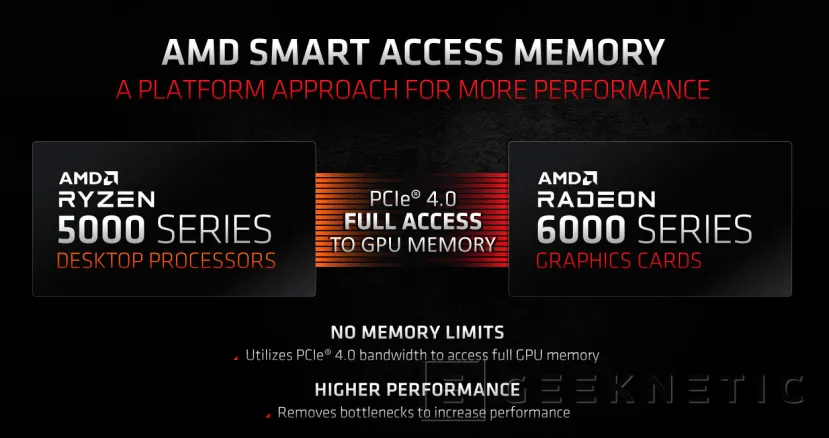
These three fundamental pillars mean that all this new high-end from AMD, from the Radeon RX 6800 to the Radeon RX 6900 , through the Radeon RX 6800 XT , allow 4k gaming and even 2k gaming with active RTX functionality.
Radeon RX 6800 GPU Specifications
Before the end of the year we will have three new Radeons on the market, all high-end and above 600 Euros, although with very competitive prices with respect to their competitors in the Nvidia RTX range. The Radeon RX 6800 and Radeon RX 6800 XT are the two presented today and have very similar designs, albeit with differences relative to size, in order to accommodate the extra watts required by the XT model.
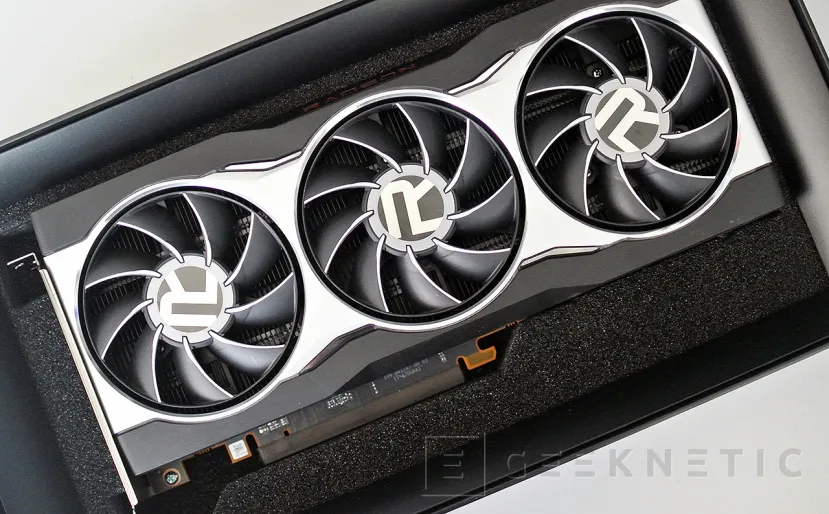
Focusing on what concerns us now, which is the Radeon RX 6800 , we can start by talking about its impressive 16GB GDDR6 RAM Framebuffer in 256-Bit configuration with a total bandwidth of 512GBps thanks to its 2GHz frequency with 16Gbps effective. To this data bus must be added the theoretical improvement introduced by the AMD Infinity Cache that can increase the bandwidth up to 3.5x in ideal situations.
These graphics also support PCI Express 4.0 and with the appropriate AMD architecture and the appropriate motherboard bios, access to Smart Memory Access technology that allows increasing the BAR of memory use of the bus to the GPU from the usual 256MB to all VRAM complete of the card which also increases the performance of the interface achieving another extra performance in the card especially in low resolutions.

This card has an energy design of 250w TDP (25 watts more than the Radeon RX 5700 XT) which indicates that its cooling system is oriented to achieve this level of cooling while maintaining an acceptable operating temperature of up to 110 degrees throughout the spectrum. It may sound like a lot, but it’s actually little more than previous generations and only 15 degrees more than what a newly released Ryzen Zen3 processor can support. With this high operating temperature range, the card can make better use of its frequency-boosting capabilities and also function better with less active ventilation. It is powered by two traditional 8-pin PEG connectors, which added to the PCI Express 4.0 Bus allow the card to have a power range of up to 450w.

As for the pure and simple technique, this card includes 60 computing units including 60 Raytracing processing units and a total of 3840 shading units . In classic rasterization we will have 240 texture units and 96 rasterization units with up to 200Gigapixels per second of processing power.

The frequencies of this model range from 1815MHz in gaming mode with frequency peaks of 2105MHz that will depend on the state of cooling and consumption of the card, especially the cooling and the temperatures that each monitored section of the CPU encapsulation develops. . Excellent numbers in general thanks to its composition with more than 26,000 million transistors capable of generating up to 32TFlops of power in single precision and up to 16TFlops in double precision.
The connectivity is of the latest generation with two Displayport 1.4 ports with 8k resolution, 1 HDMI 2.1 VRR (Variable Refresh Rate) connector and a USB-C port with full functionality that includes Displayport Alternate Mode, USB 3.1 and USB-C PD support with up to 30w load power. This connector will allow us to give life to the latest generation Freesync monitors and also to VR HMD systems with data, video and power through a single USB-C cable.
Reference Design
AMD’s reference model for the newer Radeon RX 6800 and Radeon RX 6800 XT are pretty much the same and have some pretty cool virtues. On the one hand, they are of a very standard size so we can mount them in compact systems, they are 267mm long and 120mm high and 40mm high, two slots, in terms of thickness in this model.
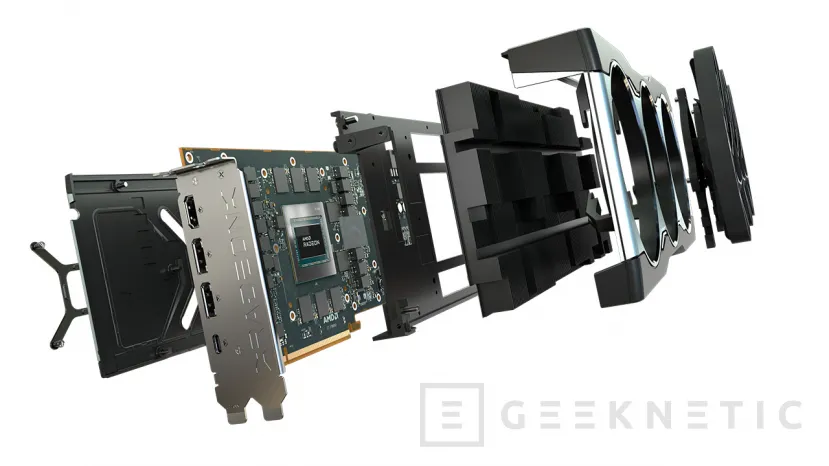
The reference cooler has increased the size of the steam chamber, places the power connections in one of the corners, and improves memory and VRM heat conductivity using new high heat conductivity pads.
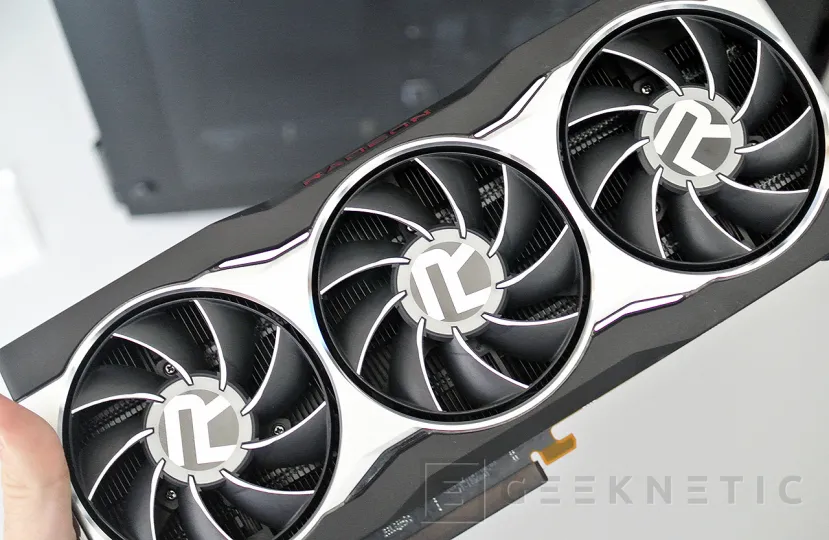
El sistema de refrigeración activa ahora corre a cargo de tres ventiladores axiales de 80mm con velocidad ajustable de forma independiente y con modo de ventilación hibrida con parada completa cuando la tarjeta está en reposo, concretamente por debajo de los 55 grados de temperatura. Esto hace que el sistema en reposo sea muy silencioso y que los ventiladores duren mas tiempo y la tarjeta se mantenga limpia también durante mas tiempo.
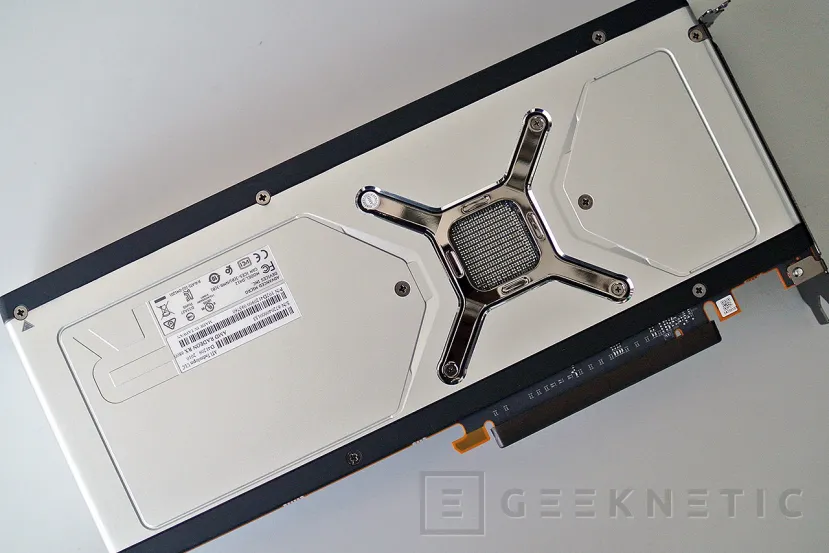
El diseño es mas moderno y elaborado que en ediciones anteriores, con un disipador negro completamente visto por el lateral y completamente cubierta y cerrada con un bonito backplate trasero que le da un gran acabado y que mejora la rigidez de la tarjeta. Los colores plata, negro y rojo se combinan también con un logo Radeon lateral iluminado mediante leds rojos.
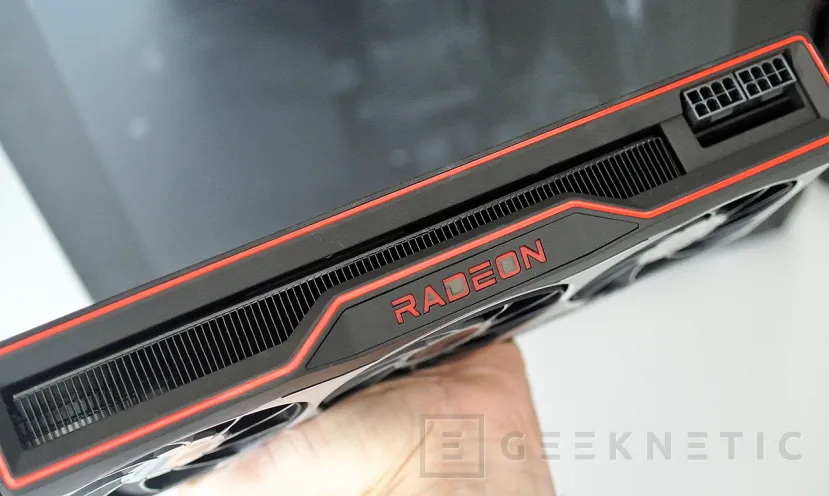
En el frontal, donde resalta un acabado sin rejilla frontal, podemos encontrar los dos conectores Displayport de tamaño completo, el HDMI también de tamaño completo y el puerto USB-C que quedara el mas cercano a la placa base. No hay selector de doble bios en esta generación, al menos no en estos modelos de referencia, pero el acabado estético, combinado con el resultado de funcionamiento, me hacen concluir con que las nuevas Radeon de referencia han ganado muchos enteros sobre la generación anterior.
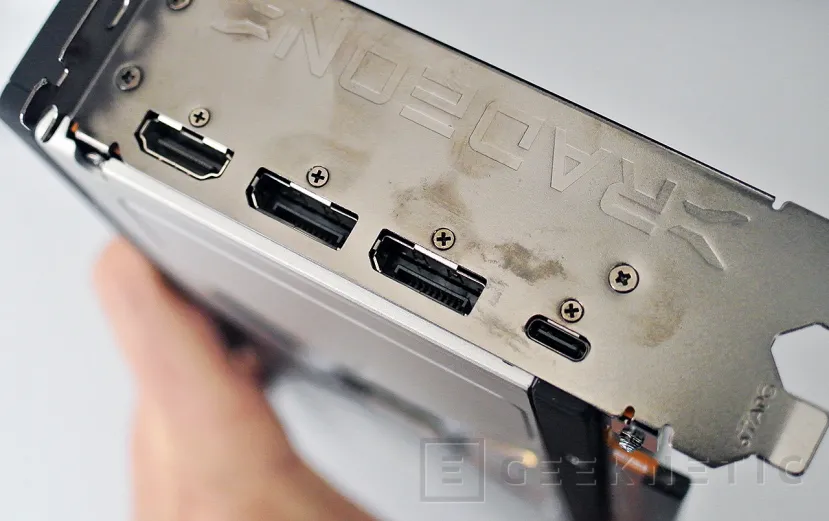
Ruido, consumo y temperatura a velocidades de serie
The Radeon RX 6800 is a card that frightens this first because of the temperatures it allows to reach and its high frequencies that invite us to think that these high temperatures are going to continuously occur in the normal behavior of the card, for example when we play.

Nothing is further from the truth since at least this reference model has an excellent behavior in its frequencies of habitual use. In fact, it develops frequencies higher than those promised without exceeding 86 degrees of temperature in the hottest point of the package, which it can now measure accurately, and above 70 in its global temperature.
Con esta temperatura y frecuencias de trabajo, mas cercanas a los 2250MHz que a los 2105MHz prometidos, los tres ventiladores trabajan sobre las 1500rpm y no producen mas de 37dBA de ruido aun metro de distancia. El comportamiento es perfecto y como veis en las capturas térmicas se puede tocar la tarjeta sin problemas cuando esta en uso. Lo que si será recomendable es una caja con buena ventilación puesto que estas tarjeas vuelcan todo el calor por el lateral, sin expulsar nada hacia el exterior.
Temperatura en reposo
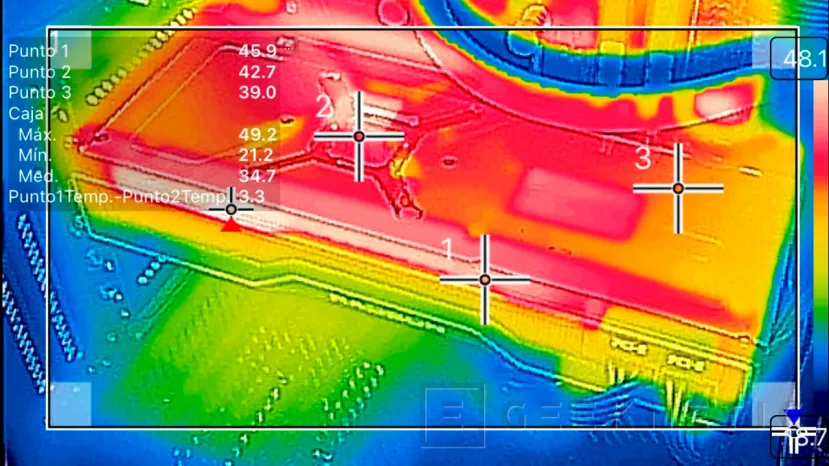
Temperatura en carga

Overclock
En cuanto a overclocking esta generación ya viene bastante bien aprovechada de fábrica pero AMD aun así ha dejado algo de margen para que podamos jugar con la tarjeta. Nosotros, sin tocar voltaje, hemos podido aumentar la frecuencia un 12% que se traduce en unos 2450MHz efectivos durante juego o pruebas con pocos picos a la baja.
Con esta frecuencia podemos ganar hasta un 5% de rendimiento en este modelo y las temperaturas de trabajo, en punto caliente, se mantienen en los 86-89 grados, con temperatura de tarjeta de menos de 70 y aumentando únicamente unas 300prm el ventilador manteniendo el ruido de la tarjeta por debajo de los 40dBA.

Pruebas DXRT, AMD Boost y AMD Smart Access Memory
Para conocer las prestaciones de esta tarjeta con algunos de sus nuevos y no tan nuevos trucos hemos cogido algunos juegos concretos capaces de aprovechar estas prestaciones y hemos hecho una breve comparativa de resultados. La mejora del Boost ya la conociamos, pero ahora tenemos tambien la opcion de usar el Ray Tracing en algunos juegos, con muy buenos resultados hasta 1440p de resolucion y tambien hemos podido comprobar la ligera pero efectiva mejora de rendimiento usando el modo de acceso completo a la memoria a traves de PCI Express 4.0.
Máquina de pruebas:
- Procesador: AMD Ryzen 3950X
- Memoria: 16GB DDR4 3600
- Fuente: Seasonic Connect 750w
- Disco duro: Corsair MP600
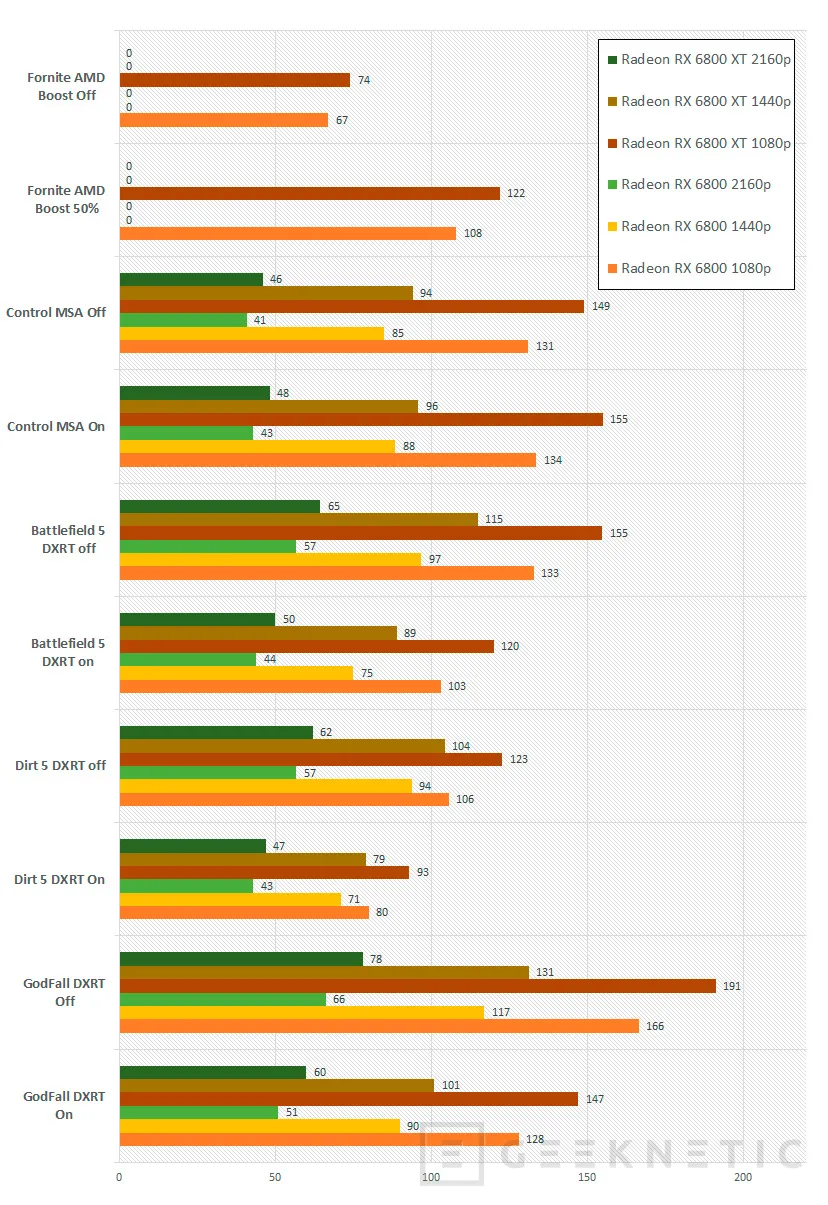
Rendimiento
Ashes of the Singularity (DX12) 1080
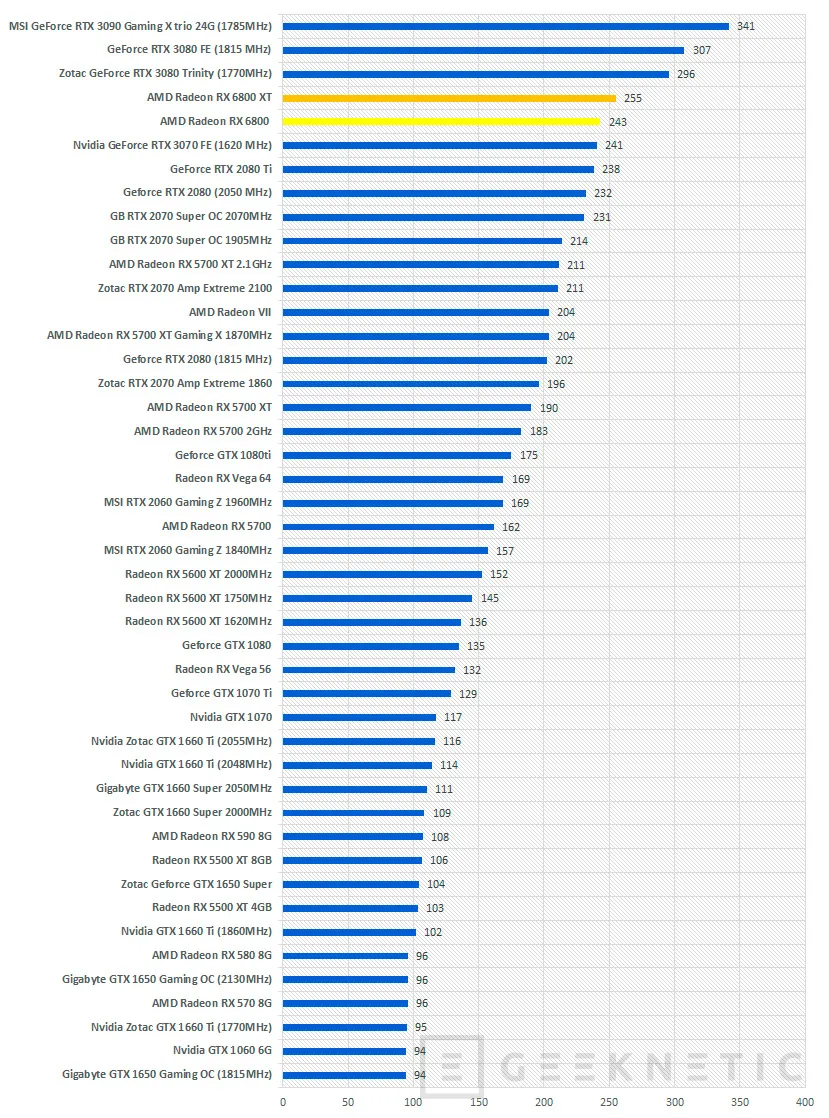
DOOM (Vulkan) ultra 1080

Halo Wars 2 (DX12) ultra 1080

Ghost Recon Wildlands (DX11) ultra 1080

Total War: Warhammer (DX12) ultra 1080

Battlefield 1 (DX12) ultra 1080
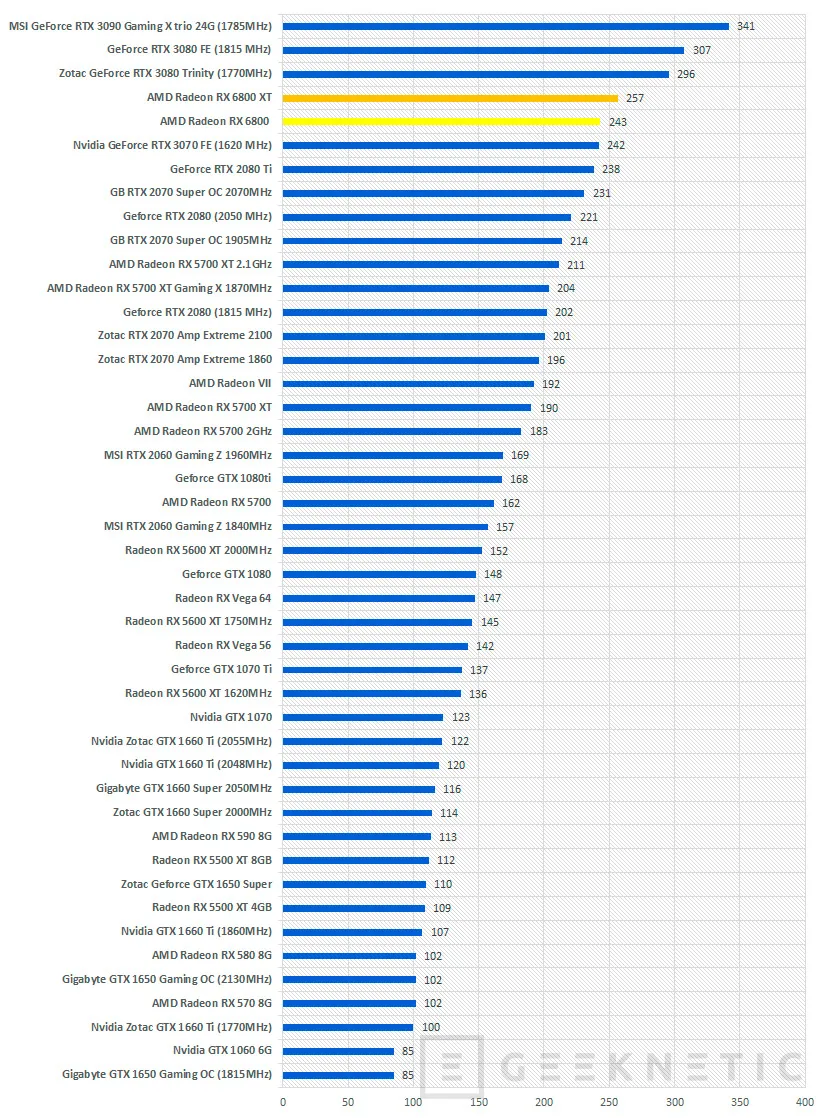
StarWars BattleFront 2 ultra (DX12) ultra 1080
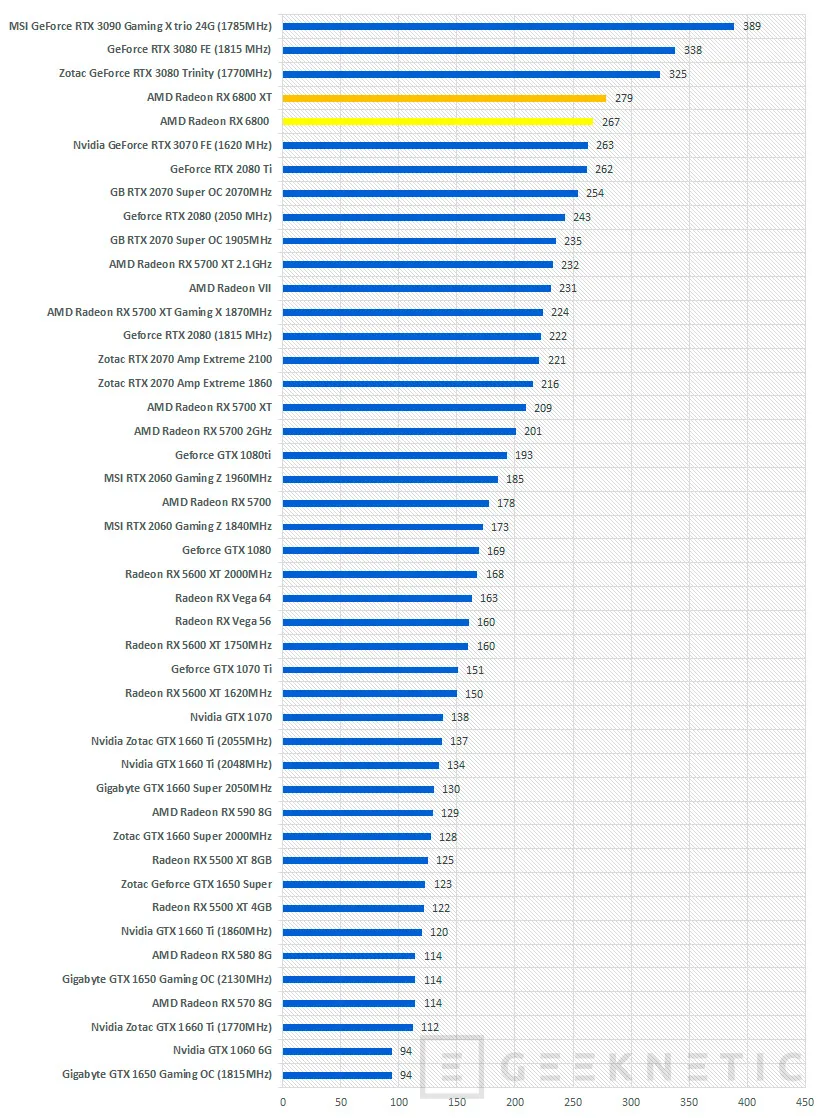
Battlefield V (DX12) ultra 1080
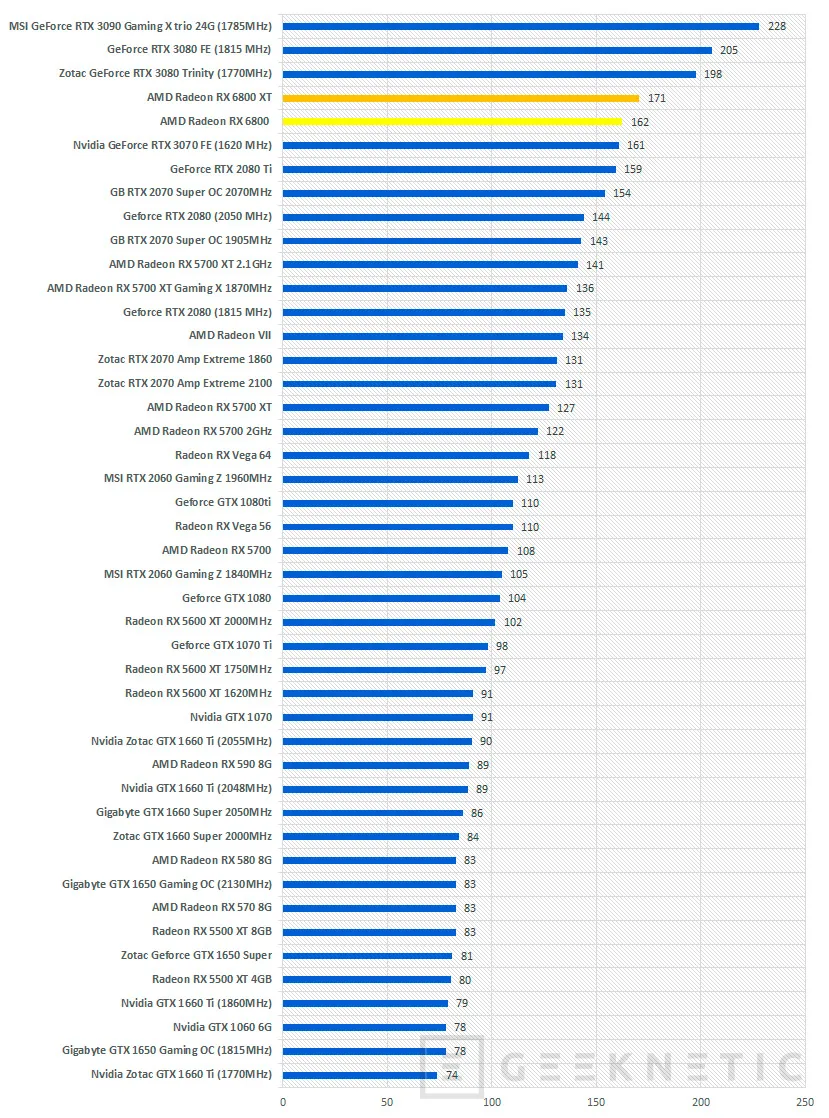
Doom Eternal ultra 1080
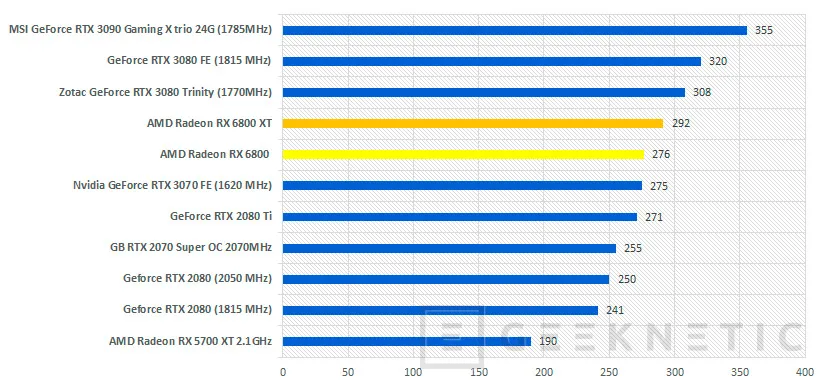
Fight Simulator Ultra 1080
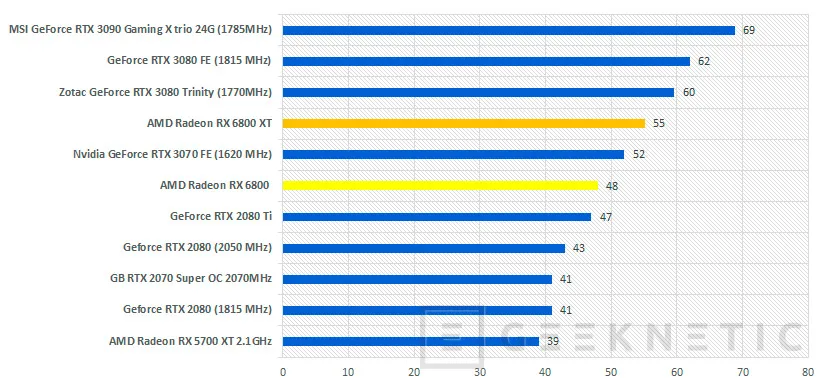
Ashes of the Singularity (DX12) 1440
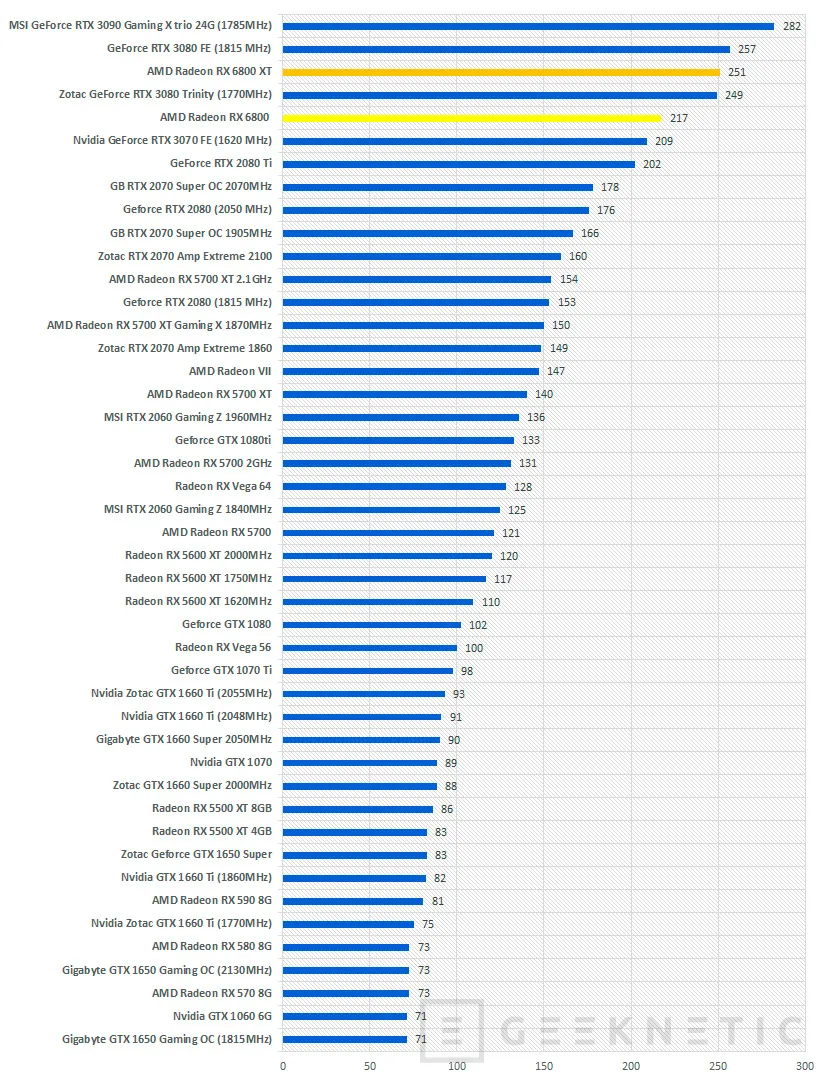
DOOM (Vulkan) ultra 1440

Halo Wars 2 (DX12) ultra 1440

Ghost Recon Wildlands (DX11) ultra 1440

Total War: Warhammer (DX12) ultra 1440

Battlefield 1 (DX12) ultra 1440
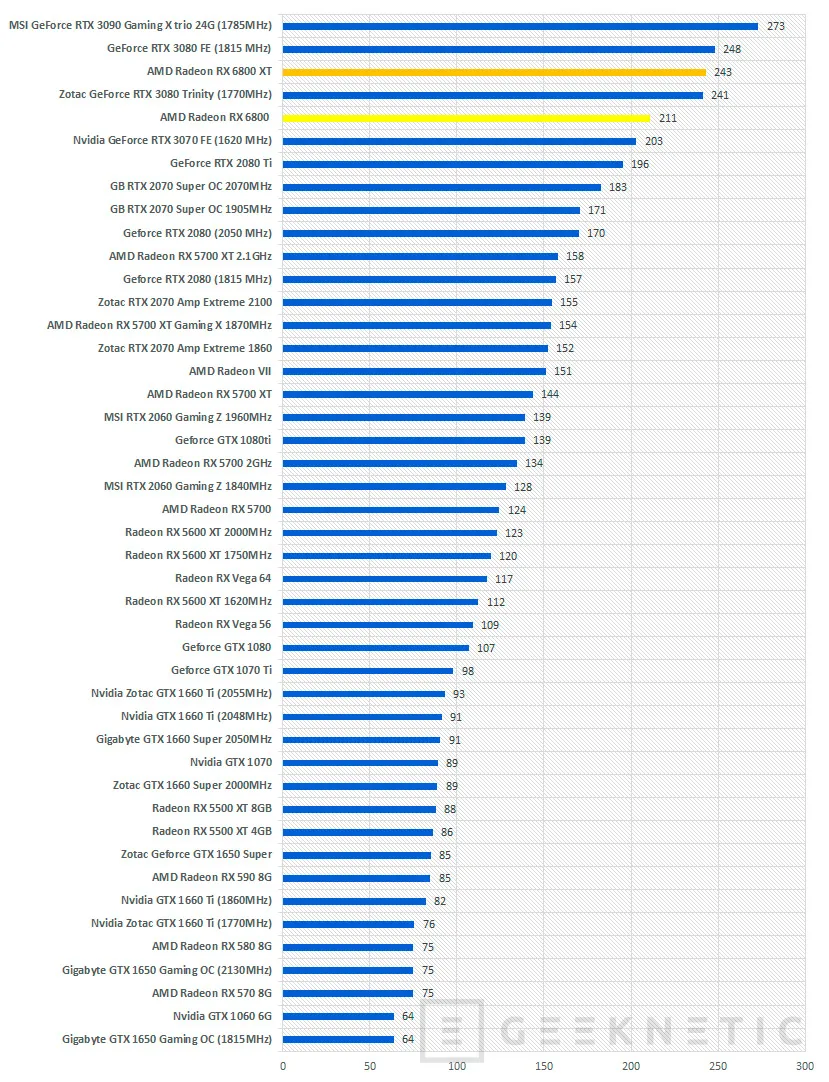
StarWars BattleFront 2 ultra (DX12) ultra 1440
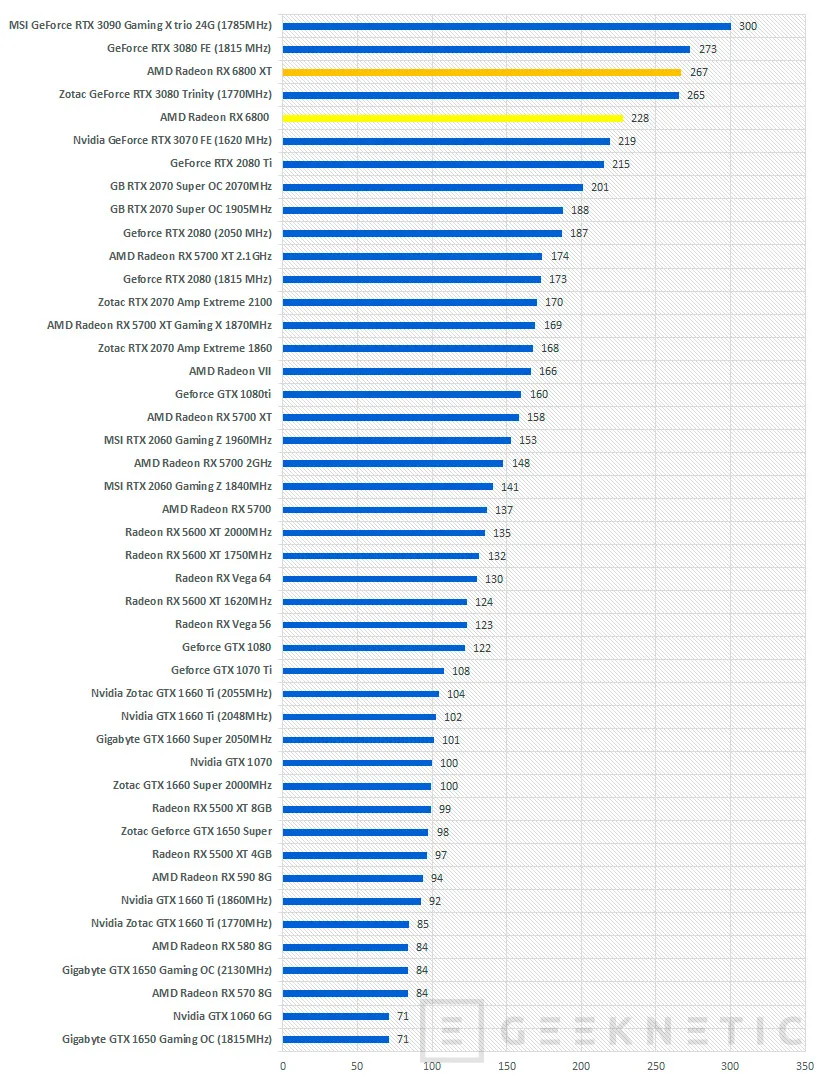
Battlefield V (DX12) ultra 1440
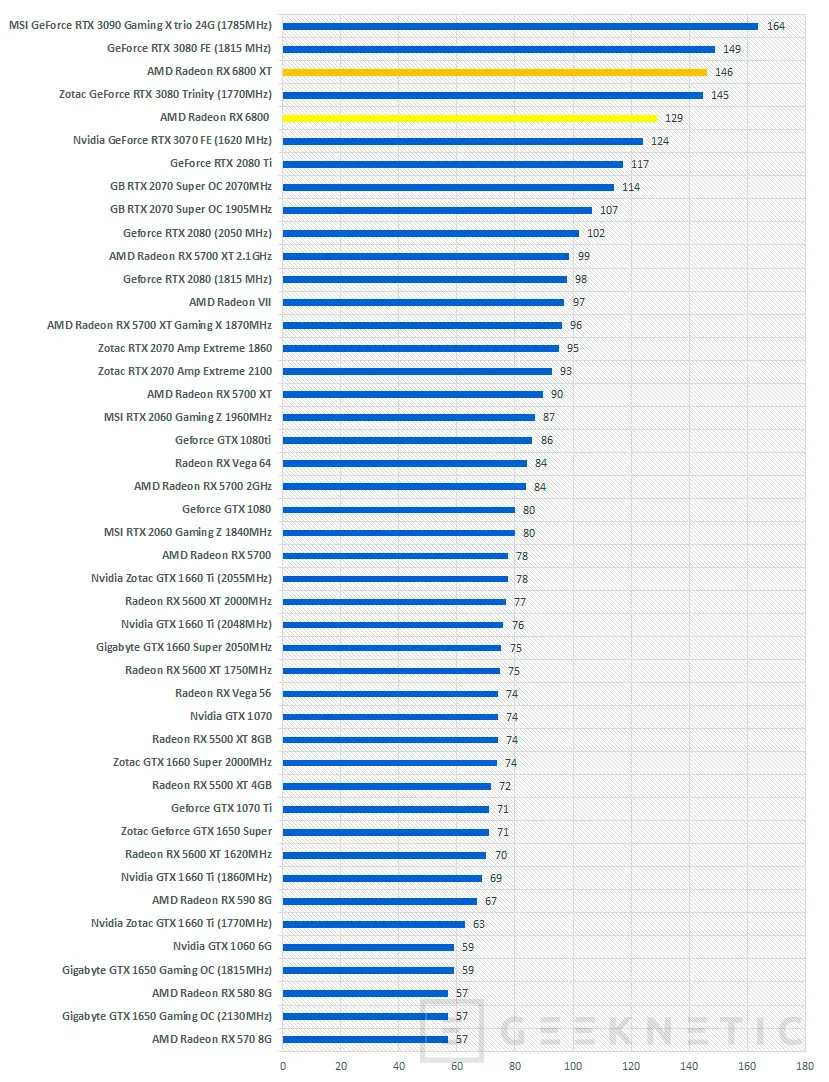
Doom Eternal ultra 1440
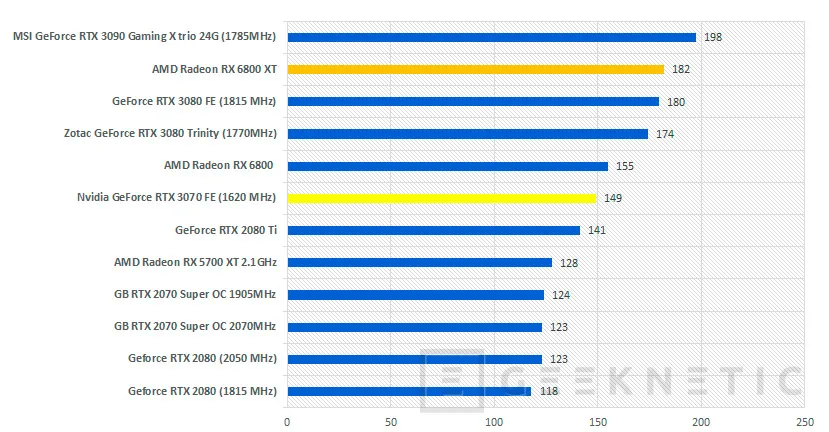
Fight Simulator Ultra 1440
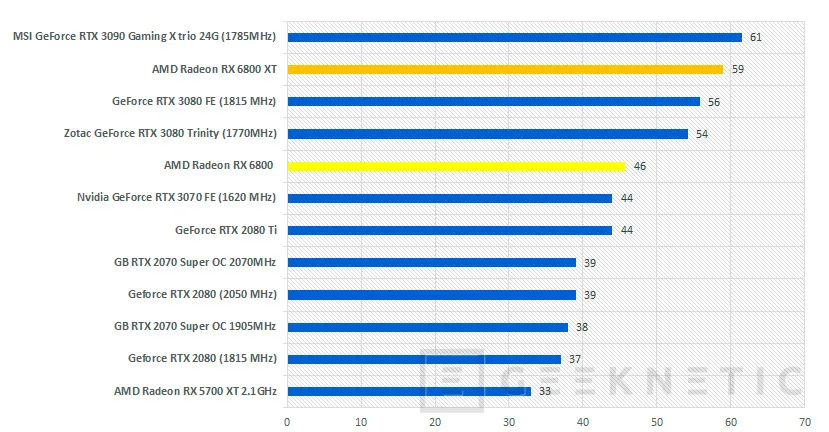
Ashes of the Singularity (DX12) 2160
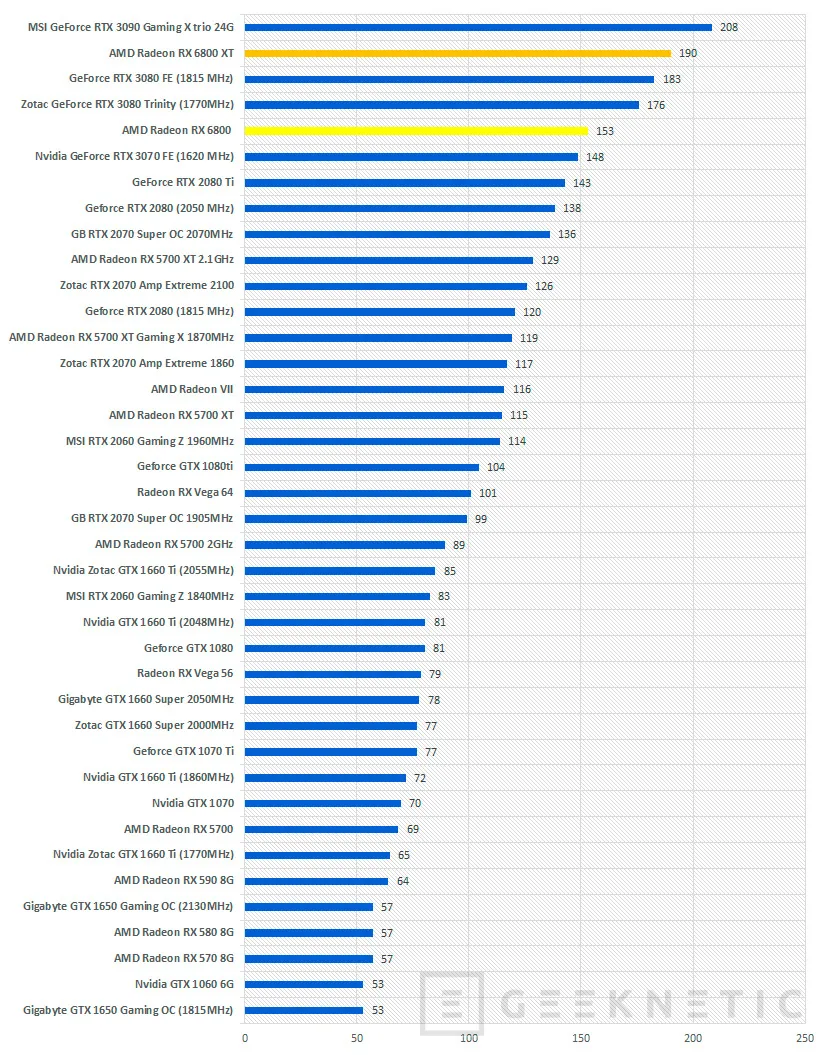
DOOM (Vulkan) ultra 2160
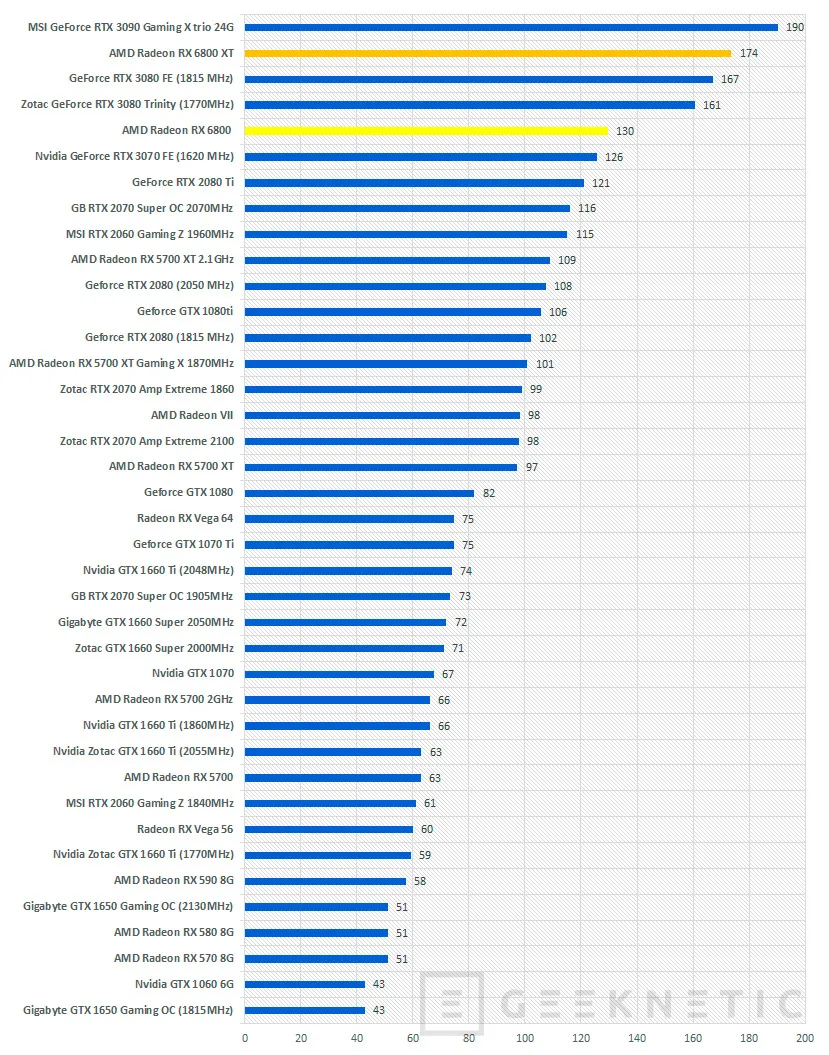
Halo Wars 2 (DX12) ultra 2160
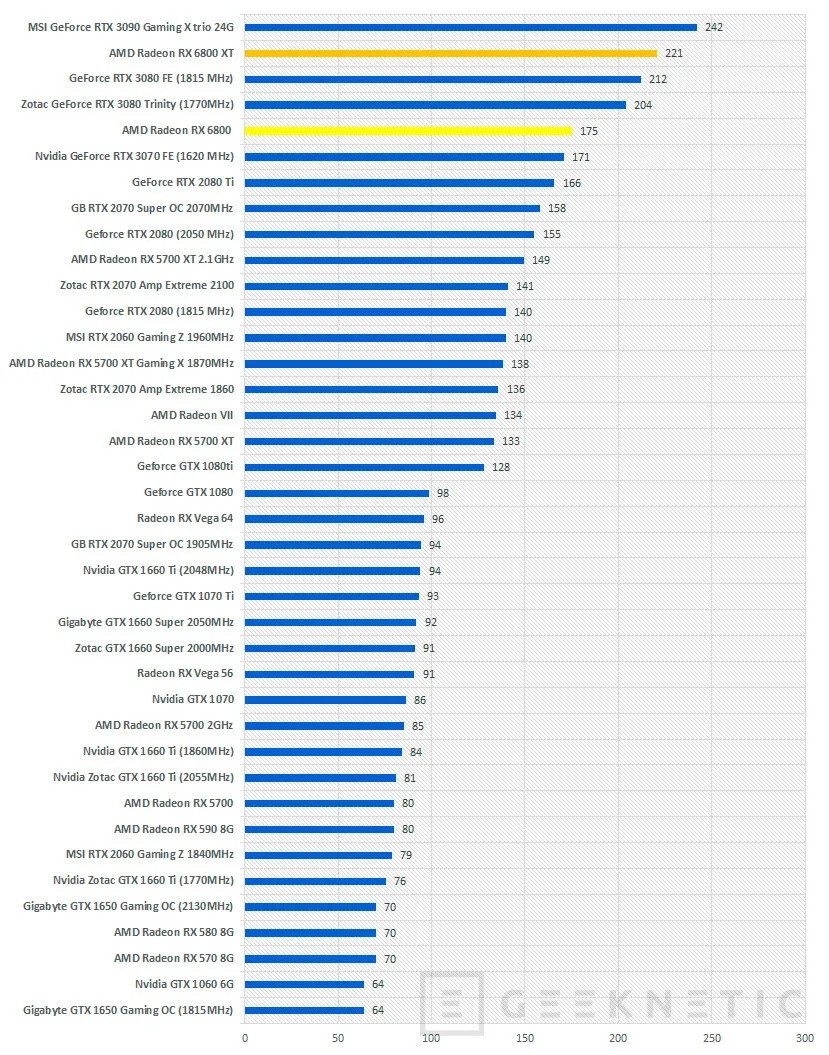
Ghost Recon Wildlands (DX11) ultra 2160
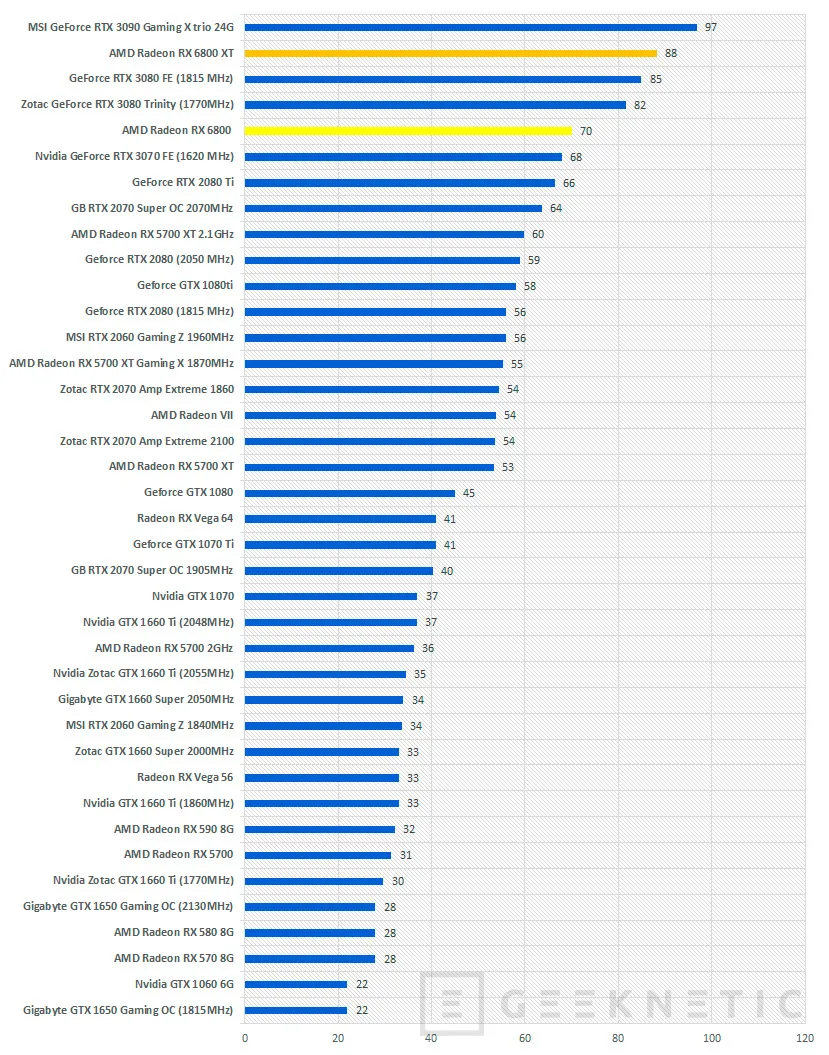
Total War: Warhammer (DX12) ultra 2160

Battlefield 1 (DX12) ultra 2160
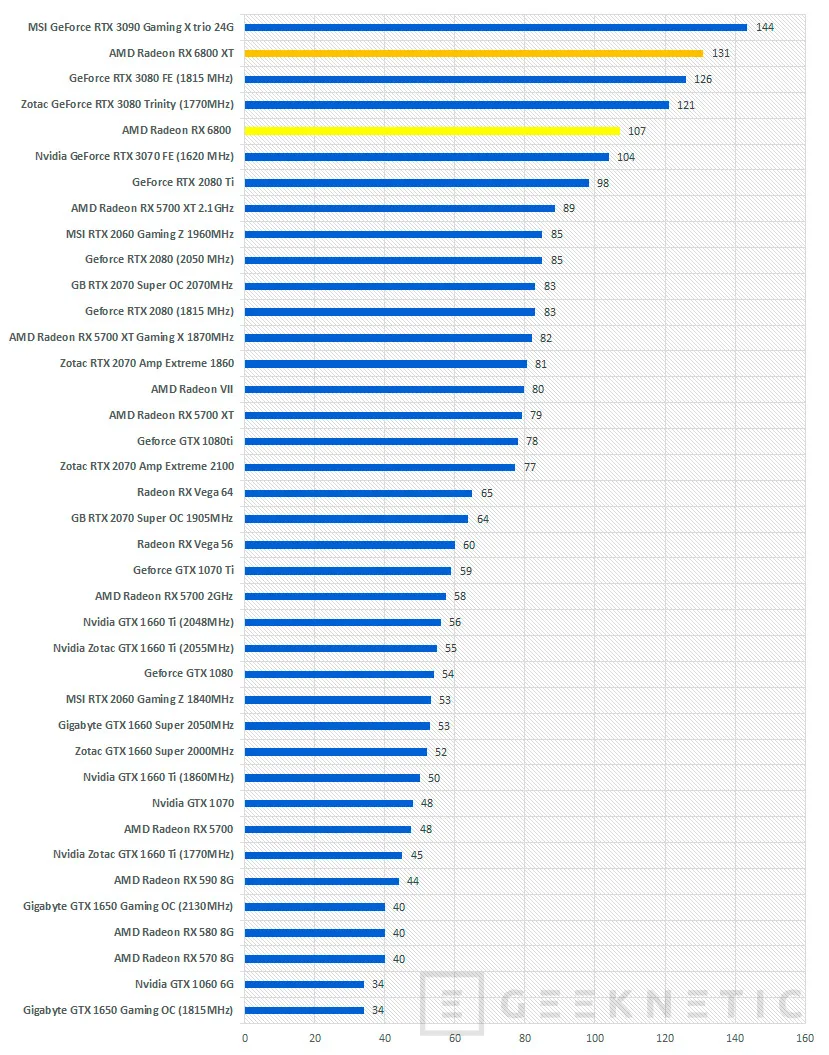
StarWars BattleFront 2 ultra (DX12) ultra 2160
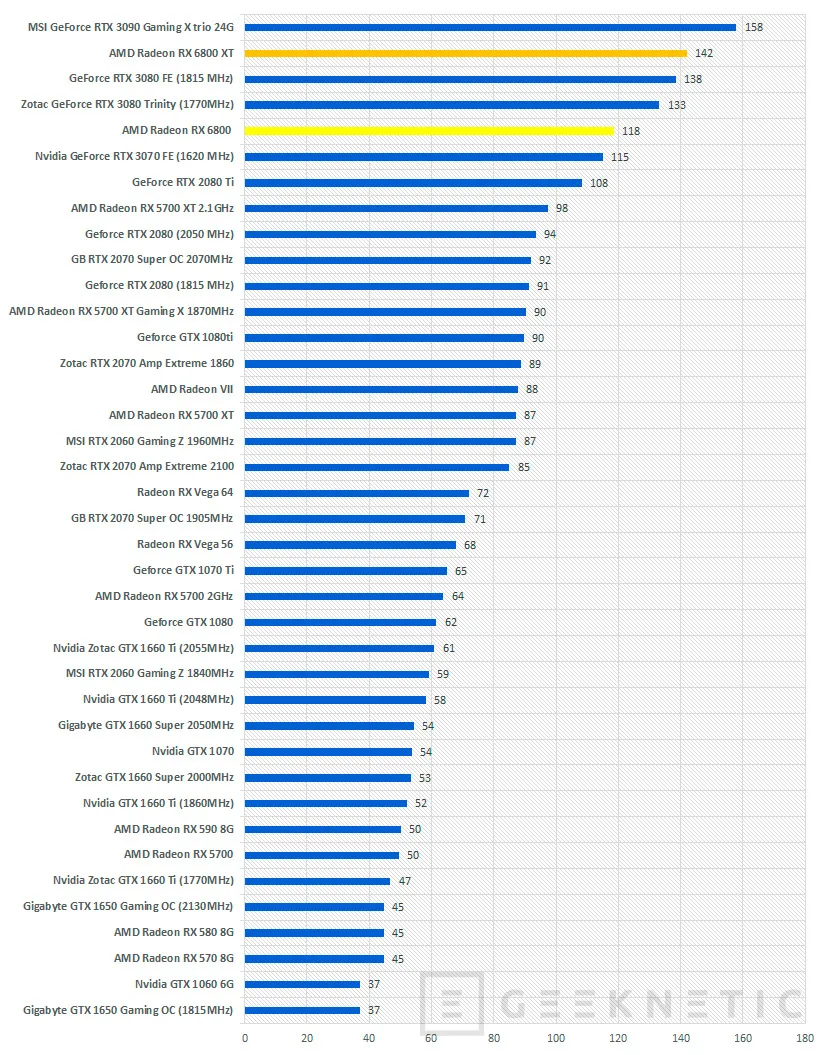
Battlefield V (DX12) ultra 2160
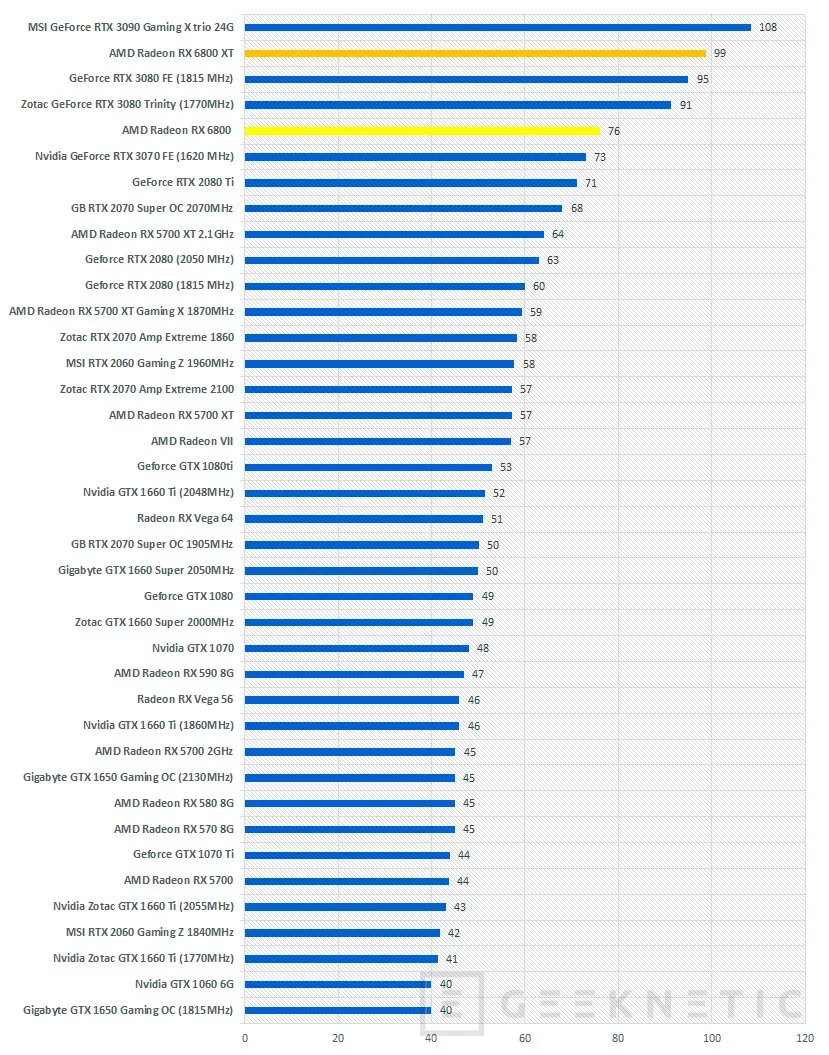
Doom Eternal ultra 2160
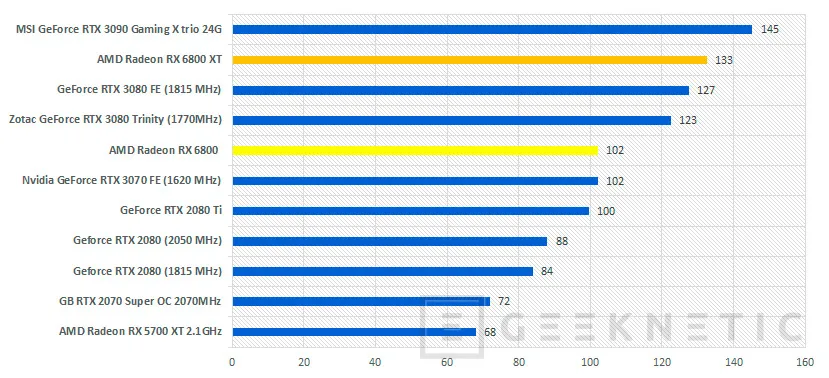
Fight Simulator Ultra 2160
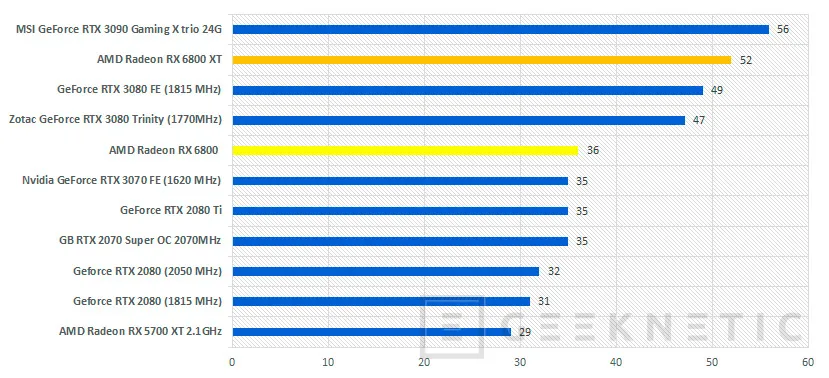
3DMark Firestrike
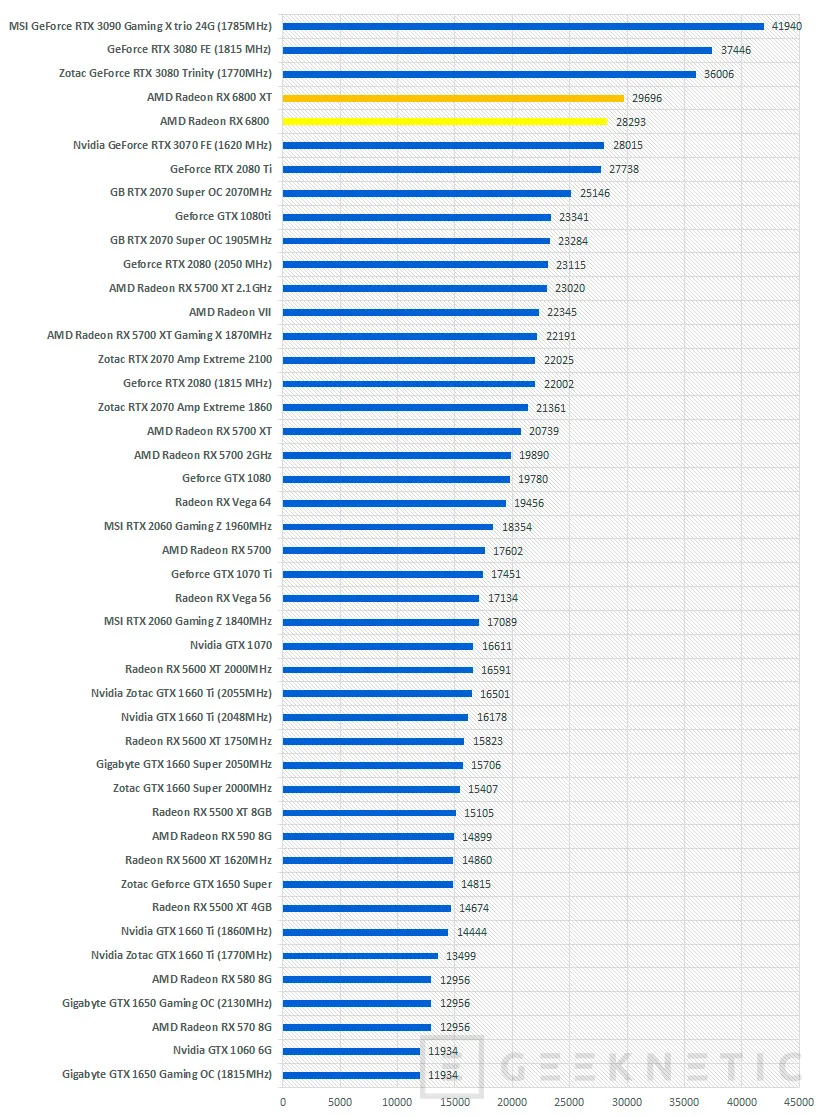
3DMark Firestrike Ultra

VRMark Orange Room
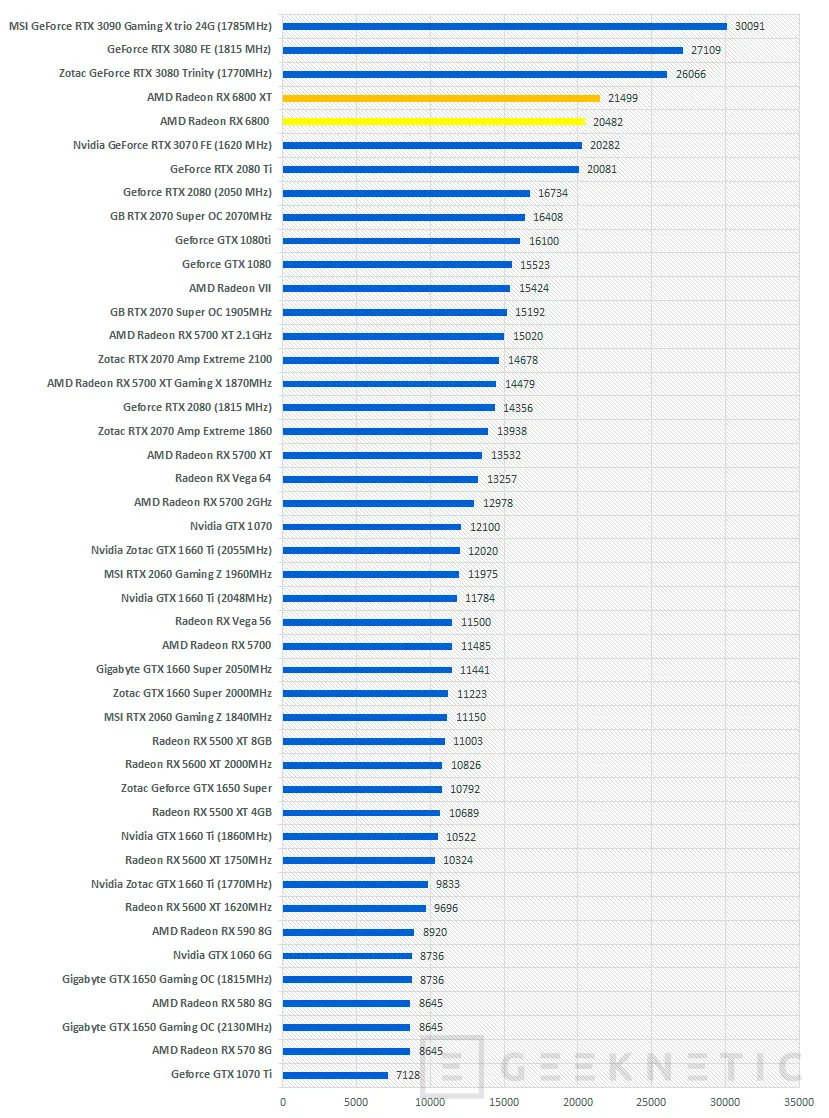
VRMark Cyan Room

Doom Eternal 4k gameplay in Ultra quality:
Analysis and conclusion
The performance results put this card in an interesting position, with performances equal to Nvidia’s RTX 3070 , up and down, and this adds to AMD’s high-frequency playability, for very fast monitors, which is what they are looking for. Now many players, but they also open up the possibility of combining this high-frequency game with very high resolution modes, with a solvent behavior in 4k and also with Ray Tracing playability with good FPS rates up to 2k resolutions.
Regarding the reference card that we analyze today, what we have found is a more silent card, much more pleasant to look at and with a management of its own capabilities that allow it to offer even more than what the manufacturer promises with sustained speeds. above spec.
I also like that AMD maintains its commitment to offering the USB-C connector as a connector for the future with a complete implementation of it including USB data, charging up to 30w and all the features of a Displayport 1.4a connector. It all adds up to achieve a fairly round card, but with a high price that has to compete with an Nvidia offer that it does not really exceed and that is in turn very solvent.





